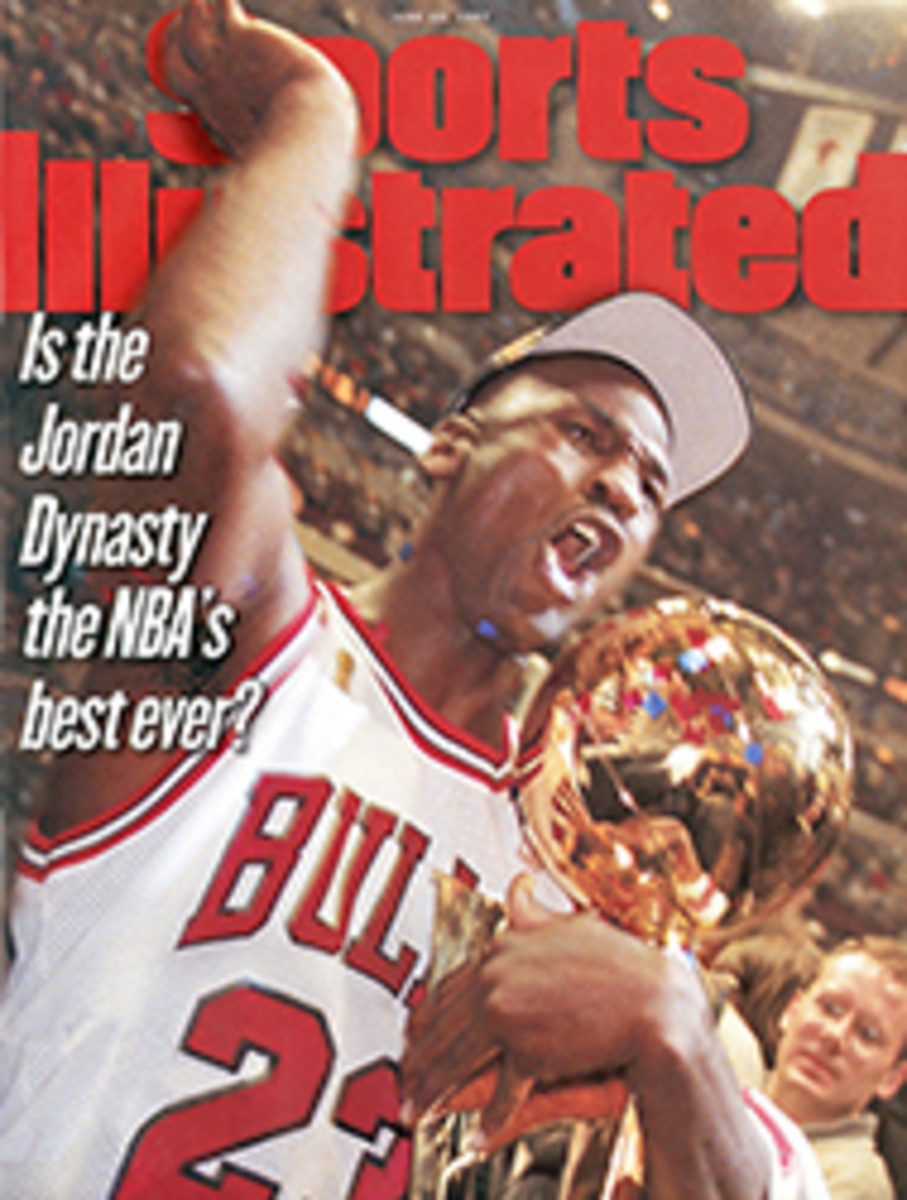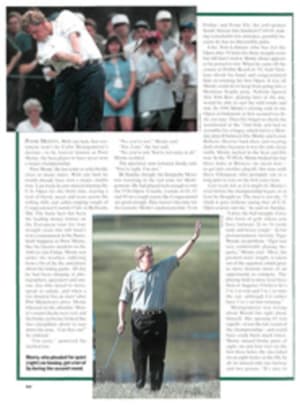
CAPITAL PUNISHMENT THE KILLER PAR-4 HOLES AT CONGRESSIONAL TURNED OUT TO BE A LOT TOUGHER THAN ANYONE HAD EXPECTED
There was a heck of a fight in Mike Tyson's backyard last week,
and the winner, by a TKO, wasn't the former heavyweight champ.
The decision went to the 475-yard 6th hole, statistically the
second-most difficult par-4 in the history of the U.S. Open
since such records have been kept, and the most dangerous of a
murderers' row of two-shotters at Congressional Country Club.
Before the championship, the most publicized hole was the 18th
because it's so rare to have a par-3 closer, especially in a
major. But what turned Congressional from a relative pussycat
into a tiger was the conversion of two holes that members play
as par-5s, the 6th (Tyson owns a house off the fairway) and the
10th, into par-4s, making par 70. The 7,213-yard course was the
longest in Open history, longer by 160 yards than Congressional
was for the '64 Open won by Ken Venturi or the '76 PGA won by
Dave Stockton, because of changes made by architect Rees Jones
in the late '80s. The 6th and 10th were also played as 4s in
those two majors.
Add the 480-yard 17th into the mix, plus the 434-yard 4th and
the 461-yard 13th, and you have an Open course to die for, to
the USGA's way of thinking. The players, most of them anyway,
thought so, too. "They want to test every aspect of your game,"
said Greg Norman. "Is it necessary to reach a par-4 in two?
Maybe not. I've read stories about Ben Hogan laying up on par-3s
to have the position to chip on and make par. Is that part of
the game? Absolutely."
History counts for a lot in golf, and the 6th added its volume
last week. Overall, it played .533 of a stroke over par, second
only to the notorious 18th at Oakland Hills (.535 over par) in
1996. Congressional's other monster par-4s weren't far behind.
Players averaged 4.479 strokes on the 10th, second hardest to
the 6th, while the 17th ranked third (4.406), the 13th fourth
(4.368) and the 4th sixth (4.301). During the first round last
week only 25% of the players hit the 6th green in regulation
(just 32.7% of the field hit the 10th). For the four rounds
34.7% made the green in two. If those kinds of numbers don't
make the 6th the toughest par-4 this side of the Road Hole 17th
at St. Andrews, the Congressional Killer at least deserves to be
included in the debate.
The key to playing the hole is the drive, which must be long and
straight for a player to have any chance of reaching the green
in two. The second shot also is tricky, even for long drivers,
because it frequently requires a long iron into a green that's
not designed to hold long iron shots. A lot of players saw their
balls hit on the green and bounce off the back edge into rough
that was as thick as spaghetti. Even the green, with its three
tiers, was no safe haven.
Before last week's opening round, Tom Lehman said he was going
to play the 6th as a par-5 if need be and "not let that hole
knock me out of the tournament." Lehman was as good as his word,
laying up twice on the hole and bogeying both times (he also
parred twice). If only others had been as wise. During the '64
Open a 52-year-old Sam Snead began his 24th quest for the only
major he hadn't won by four-putting the 4th and then
three-putting the 6th. After the latter, Slammin' Sammy fired
his ball into the pond that guards the front right portion of
the green. In the '76 PGA, Jack Nicklaus took the lead early in
the final round but quickly fell out of contention at the 6th
when he dumped his second shot into the water.
The 6th claimed plenty of victims this year, too. Mark Wiebe,
still trying to recover from the previous week's Kemper Open,
which he blew by missing short putts on the last two holes,
five-putted the 6th green on Friday. "I couldn't get it in to
save my life," he said. "In fact I lipped in the fifth one." In
the first round John Daly blasted the longest drive of the day,
leaving only a seven-iron shot. But he bounced his approach
through the green and into the rough, where the ball
disappeared. Vanished! After a long search, marshals found a
ball, but it was so deeply embedded that Daly couldn't say for
sure that it was his. He marked the ball in the rough, picked it
up and identified it, then shoved it back down into the deep
grass. Daly blasted over the green into more rough before
chipping on and two-putting for a double bogey.
Daly's misfortune brought to mind a comment Gary Player made
before the '76 PGA. "I've been telling people all my life that
long courses don't necessarily favor long hitters," said Player.
"People see 7,000 yards, like we have here, and they immediately
predict that [anybody] who hits the ball a mile will win. The
fact is, long courses favor the guys with good short games." But
the short knockers were at a decided disadvantage at 6. Hale
Irwin, a three-time Open champ, hit his second shot into the
drink on Thursday. "I hit a four-wood a little off the toe and
pushed it," he said. "The ball hit the rock wall and bounced
back into the water. Another step and I'd have been on the
green. I had to make a nice 20-foot putt to save bogey."
Corey Pavin had an even more embarrassing moment. He hit a drive
of 235 yards on the 6th in the first round and still had 240 to
the green. Trying to cream a three-wood, Pavin heeled the shot
way left. His ball hit a pine tree, which saved it from ending
up on the 7th fairway but forced him to wedge out to about 70
yards short of the green. He flopped it on from there and
two-putted for a smooth double bogey.
As if to add to the Nicklausian connection to the 6th, Gary,
Jack's 28-year-old son, on Friday reprised his father's famous
meltdown of '76. Gary drove into the rough, wedged out, plopped
his third into the water, put the next shot on and two-putted
for a triple. If Gary had parred the hole, he would've
celebrated Father's Day with his dad on the course instead of in
his dad's gallery.
Not all the news from the 6th was bad. Colin Montgomerie, for
example, said his par on the hole on Thursday jump-started his
round and propelled him to a 65. After driving into the left
rough, Montgomerie took a sand wedge and hacked out. Still 157
yards from the green, he hit an eight-iron stiff. "The 6th was
vital for me," he said. "That was the most important par I've
made in a long time. If I'd made five, which was in the cards, I
possibly wouldn't have birdied 7, and, therefore, not 9, 10 and
11."
Clearly the 6th had the ability to make or break rounds. Said
Brad Faxon, "You have fear in your mind when you step up on the
6th."
That's the way it's supposed to be in the Open. Make those
suckers hit long irons and pray. Last week Congressional
reminded us that there's nothing like a good championship fight,
and the one held in Mike Tyson's backyard was the best of them
all.
COLOR PHOTO: SIMON BRUTY Els bogeyed the diabolical 6th (opposite) on Sunday but felt like a champ after making birdie at the 10th. [Aerial view of 6th hole at Congressional Country Club]
COLOR PHOTO: JOHN IACONO [See caption above--Ernie Els on green]
COLOR PHOTO: HEINZ KLUETMEIER Thousands could see the Open play out on the critical 480-yard 17th (left) and the par-3 18th. [Crowd watching golfers on 17th and 18th holes of Congressional Country Club]

